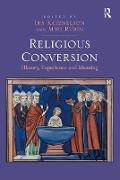Read more
This collection ranges far and wide - from early Christian pilgrims to fifteenth-century Ethiopia; from the Islamisation of the eastern Mediterranean to Reformation Germany - to investigate the multiple causes and characteristics of religious conversion. By probing continuities and fissures, particularly in the Jewish, Muslim and Christian experien
List of contents
Introduction, Katznelson Ira, Rubin Miri; Chapter 1 Conversion of Space, Limor Ora; Chapter 2 Demography, Geography and the Accelerated Islamisation of the Eastern Mediterranean, Ellenblum Ronnie; Chapter 3 The Christianisation of Time in Fifteenth-Century Ethiopia, Kaplan Steven; Chapter 4 Church Space and Religious Change in Reformation Germany, Heal Bridget; Chapter 5 Changing Minds – Changing Bodies: The Gendered Subject of Conversion, Levinson Joshua; Chapter 6 Conversion and Masculinity in the Early Medieval West, Hen Yitzhak; Chapter 7 1I would like to thank my colleague at Canterbury, Maria Diemling, for her comments on the text and for her advice with the translation. The draft of this article has been finished at the end of 2009. Newly published literature has not been accounted for since then. Please note the following publications though: Rotraud Ries, Zwischenraeume – Orte, Worte und Wege von Konvertiten zwischen Judentum und Christentum, in Christoph Bultmann, Joerg Ruepke, Sabine Schmolinsky (eds), Religionen in Nachbarschaft. Pluralismus als Markenzeichen der europaeischen Religionsgeschichte (Muenster: Aschendorff Verlag 2012), 87–108; Annekathrin Helbig, Konversion, Kindheit und Jugend – Taufen jüdischer Kinder im 18. Jahrhundert, WerkstattGeschichte 63 (2013), 45–60; Michaela Schmoelz-Haeberlein, Juden in Bamberg (1633-1802/03). Lebensverhaeltnisse und Handlungsspielraeume einer staedtischen Minderheit (Wuerzburg: Ergon 2014) (Judentum – Christentum – Islam. Interreligioese Studien 11), 213–240., Ries Rotraud; Chapter 8 1This article is partly based on a paper presented at the 85th annual meeting of the Medieval Academy of America, Yale University, 18–20 March, 2010., Yisraeli Yosi; Chapter 9 1This article is based on a broad on-going research project which examines attitudes of Jews towards other Jews who had converted to Christianity. Its results will be published in Apostasy and Jewish Identity in High Middle Ages Northern Europe: Are you still my brother? (Forthcoming 2015, Manchester University Press), Goldin Simha; Chapter 10 ‘Double Conversions’ in the Early Modern Period: The Road to Religious Scepticism?, Heyd Michael;
About the author
Ira Katznelson is Ruggles Professor of Political Science and History at Columbia University, New York. Primarily an Americanist, his work has straddled comparative politics and political theory as well as political and social history. He is President of the Social Science Research Council, and was President of the American Political Science Association for 2005-2006. Previously, he served as President of the Social Science History Association and Chair of the Russell Sage Foundation Board of Trustees. He has been a Guggenheim Fellow and is a Fellow of the American Academy of Arts and Sciences and the American Philosophical Society. His most recent books are ’Fear Itself: The New Deal and the Origins of Our Time’ (2013), ’Liberal Beginnings: Making a Republic for the Moderns’ (with Andreas Kalyvas) (2008), and ’When Affirmative Action Was White: An Untold History of Racial Inequality in Twentieth-Century America’ (2006). Miri Rubin is Professor of Medieval and Early Modern History and Head of the School of History, at Queen Mary, University of London. Her research has ranged across the period 1100-1600, introducing fresh approaches to the study of social relations in the predominantly religious cultures of medieval Europe. Her publications include: ’Charity and Community in Medieval Cambridge (1987); ’Corpus Christi: the Eucharist in Late Medieval Culture’ (1991) and ’Gentile Tales; the Narrative Assault on Late Medieval Jews’ (1999; repr. 2004).
Summary
This collection ranges far and wide - from early Christian pilgrims to fifteenth-century Ethiopia; from the Islamisation of the eastern Mediterranean to Reformation Germany - to investigate the multiple causes and characteristics of religious conversion. By probing continuities and fissures, particularly in the Jewish, Muslim and Christian experien

